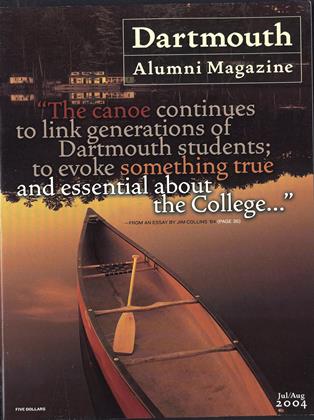On living lightly—in a hay house
"After a story about the Hay Houseappeared in Connecticut Magazine I had groups of people coming by almost daily, some of them Japanese tourists with videocams. We finally put up a sign saying: 'Nature Trail to the Left; Hay House by Appointment Only.'"
"There is something so satisfyingabout physical labor. Too many people employ labor-saving devices to the point of absurdity. Then they go to the gym."
"I don't feel I'm roughing it. Friends who invite me over for dinner know I'll show up with my towel and a bar of soap."
"I'm not anti-technology. I drive a truck. I have a phone and an answering machine."
"People tell me I can't keep up with out television. I question what I'd be keeping up with. If people would put the four or five hours a day they invest in TV viewing into gardening, can you imagine how much more exciting their lives would be?"
"Sometimes I think I'd enjoy a certain movie but I read the reviews and feel like I've seen it."
"I dream of not leaving my property for an entire year. If someone had told me in high school that Fd be living- in Old Saybook when I was 50, I'd have done something" drastic to myself."
"When you move around a lot you lose the importance of place. You don't have a vested interest in your community, of protecting the watershed or conserving the land."
"I lived in the Outward Bound Housein Hanover. The people I lived with were very outdoorsy. We never had any clothes on if we were anywhere near water. Now kids are so uptight they'd swim in their blue jeans."
"I grew up in an Old Saybrook neighborhood that was literally a community of Dartmouth interviewers. No way was I going to live in the wilderness with 4,000 horny jocks. I chose Middlebury not just because it was coed; it let me take 14 art courses in my first two years."
"I can't recall exactly how I ended up transferring to Dartmouth. My mother applied for me while I was taking a year off in Asia. Who better than your mother to make a case for you?"
"Living in Nepal taught me how much is enough. The message of my Hay House installation is that a 345-square-foot house is more than enough."
"Deciding not to sell my produce and to concentrate on myart was a real leap of faith."
"Most artists are terrible at promoting their own art. I could promote someone else's, but when it comes to my own I stutter, I apologize."
"I prefer to paint portraits, but my landscapes sell better. I invite people to sit for me and it's all about the interaction. Painting from a photograph would be painting the photograph."
"Americans tend to forget that art is produced by livingpeople—most of whom exist at the poverty level. I continue to qualify for the earned-income credit."
"My lasting contribution as a member of the Old Saybrook board of education was getting them to introduceforeign languages in kindergarten. I'd seen in Nepal how instandy kids that age can learn new things."
"At one point I was spending 30 hours a weekon community boards, which is great for someone retired or someone wealthy. I had to stop. Still, I will never turn down a personal request for help. I'll teach an immigrant English, help someone find a job, find a kid a bike."
"Measurements of happiness are inversely related to wealth. If I were to subtitle my Hay House installation it would be, 'Who's Rich?'"
EDUCATION: Transferred to Dartmouth after two years as an art major at Middlebury College; A.8., geography; MALS, anthropology, Wesleyan University, 1989 CAREER: Artist and former, Old Saybrook, Connecticut; former teacher, Village School in Syrabu, Nepal, 1976-78, and Hammonassett School in Madison, Connecticut, 1987-91 NOTABLE ACHIEVEMENTS: Since 1986 has been living without electricity or plumbing in a 15-by-23-foot home constructed of stucco-covered hay bales; installation of his 12-by-20-foot Hay House replica will be at the Florence Griswold Museum, Old Lyme, Connecticut, this fall. Member, Old Saybrook board of education, 1993-97 PERSONAL: Single
 View Full Issue
View Full Issue
More From This Issue
-
 Cover Story
Cover StoryCanoes Undying
July | August 2004 By JIM COLLINS ’84 -
 Feature
FeatureShoot to Thrill
July | August 2004 By DAVID MCKAY WILSON -
 Feature
FeatureUnderstanding Failure
July | August 2004 By JULIE SLOANE ’99 -
 Feature
FeatureOn The Water
July | August 2004 By JIM COLLINS '84 -
 Faculty Opinion
Faculty OpinionTrade, Jobs and Politics
July | August 2004 By Douglas A. Irwin -
 Sports
SportsYouth at Risk
July | August 2004 By Irene M. Wielawski
Lisa Furlong
-
 CONTINUING ED
CONTINUING EDRichard F. Miller ’62
Mar/Apr 2009 By Lisa Furlong -
 Continuing Ed
Continuing EdJean Hanff Korelitz ’83
Mar/Apr 2013 By Lisa Furlong -
 Article
ArticleShe’s a Keeper
MARCH | APRIL 2014 By Lisa Furlong -
 CONTINUING ED
CONTINUING EDAnn Fromholz ’90
MARCH | APRIL 2018 By LISA FURLONG -
 CONTINUING ED
CONTINUING EDRachel Dratch '88
NOVEMBER | DECEMBER 2022 By LISA FURLONG -
 CONTINUING ED
CONTINUING EDCAROLINE POTT '02
SEPTEMBER | OCTOBER 2024 By Lisa Furlong
Continuing Ed
-
 Continuing Ed
Continuing EdH. Carl McCall ’58
Sept/Oct 2000 By Jacques Steinberg ’88 -
 Continuing Ed
Continuing EdGretchen Teichgraeber ’75
Mar/Apr 2002 By Lisa Furlong -
 Continuing Ed
Continuing EdKyrie Robinson ’90
July/Aug 2010 By Lisa Furlong -
 Continuing Education
Continuing EducationNancy (Denny) Kellogg ’78
Nov/Dec 2010 By Lisa Furlong -
 CONTINUING ED
CONTINUING EDDavid Shribman ’76
SEPTEMBER | OCTOBER 2018 By LISA FURLONG -
 CONTINUING ED
CONTINUING EDNathaniel Fick’99
JANUARY | FEBRUARY 2023 By LISA FURLONG

